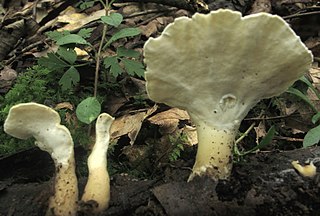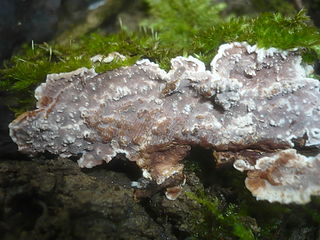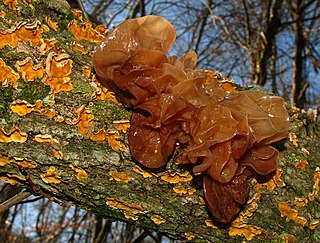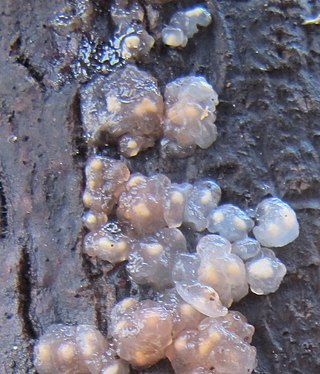
Auricularia is a genus of fungi in the family Auriculariaceae. Basidiocarps are typically gelatinous and ear-shaped, with a slightly downy to conspicuously hirsute upper surface and an under surface that is smooth, wrinkled or veined. All species grow on wood. Several Auricularia species are edible and commercially cultivated on a large scale in China and East Asia.

Loweomyces is a genus of six species of poroid fungi in the family Steccherinaceae.
Eichleriella is a genus of fungi in the order Auriculariales. Species produce effused or cupulate, waxy to leathery basidiocarps on wood, with a smooth to spiny surface. The genus contains some twelve species.
Heterochaete is a genus of fungi in the order Auriculariales. Species produce effused, gelatinous, waxy, or leathery basidiocarps on wood, partly or wholly covered in small sterile spines or pegs. The presence of these sterile spines distinguishes the genus from Exidiopsis, species of which are microscopically similar but have smooth basidiocarps.

Heteroradulum is a genus of fungi in the order Auriculariales. Species produce effused, leathery basidiocarps on wood, often pinkish red and partly or wholly covered in small sterile spines. The genus was originally published in 1917 by American mycologist Curtis Gates Lloyd under the facetious pseudonym "McGinty", rendering the name invalid. It was validated a century later to accommodate a group of species formerly placed in the genera Eichleriella or Heterochaete, but not closely related to either.

Ditangium is a genus of fungi in the family Sebacinaceae. Species form gelatinous basidiocarps (fruitbodies) on wood, often with similarly gelatinous anamorphs. The former were previously referred to the genus Craterocolla, whilst the latter were referred to Ditangium. Following changes to the International Code of Nomenclature for algae, fungi, and plants, the practice of giving different names to teleomorph and anamorph forms of the same fungus was discontinued, meaning that Craterocolla became a synonym of the earlier name Ditangium.

Myxarium nucleatum is a species of fungus in the family Hyaloriaceae. In the UK, it has been given the recommended English name of crystal brain. Basidiocarps are watery white, pustular or lobed, and gelatinous with small, white, mineral inclusions visible to the naked eye. It is a common, wood-rotting species in Europe, typically growing on dead attached or fallen branches of broadleaf trees. It is currently not clear whether collections from North America and elsewhere represent the same species.
Protomerulius is a genus of fungi in the order Auriculariales. Basidiocarps are formed on dead wood and have an effused, smooth, spiny, or poroid hymenium. The genus is cosmopolitan.
Aporpium is a genus of fungi in the order Auriculariales. Basidiocarps are formed on dead wood and have a poroid hymenium. Species were often formerly referred to the genera Elmerina or Protomerulius, but molecular research, based on cladistic analysis of DNA sequences, has shown that Aporpium is a distinct, mainly north temperate genus.
Elmerina is a genus of fungi in the order Auriculariales. Basidiocarps are formed on dead wood and are either bracket-like with a poroid hymenium or densely clavarioid. Species are known from East Asia and Australia.

Phaeotremella frondosa is a species of fungus in the family Phaeotremellaceae producing brownish, frondose, gelatinous basidiocarps. It is widespread in north temperate regions, and is parasitic on other species of fungi that grow on dead attached and recently fallen branches of broadleaf trees.
Protohydnum is a genus of fungi in the order Auriculariales. Protohydnum cartilagineum, the type and only species, occurs in Central and South America and produces effused, cartilaginous basidiocarps on wood, yellow-ochre and wholly covered in small spines. Molecular research, based on cladistic analysis of DNA sequences, has shown that the genus is distinct, but that other species previously referred to Protohydnum belong in the genera Hyalodon or Elmerina.

Myxarium is a genus of fungi in the family Hyaloriaceae. Basidiocarps are gelatinous and effused or pustular. The genus is cosmopolitan. All species grow on dead wood or dead herbaceous stems.
Adustochaete is a genus of fungi in the family Auriculariaceae. Species produce effused basidiocarps on wood, typically covered in small sterile spines or pegs. The genus was created as a result of molecular research, based on cladistic analysis of DNA sequences, to accommodate two species from Brazil and Mexico that are not closely related to the older and superficially similar genus Heterochaete. Two additional species, from Brazil and China, have since been described.
Tremellochaete is a genus of fungi in the family Auriculariaceae. Species produce pustular or lobed, effused, gelatinous basidiocarps on wood, typically covered in small sterile spines or pegs.
Proterochaete is a genus of fungi in the family Auriculariaceae. The type and only species, Proterochaete adusta, produces thin, effused, corticioid basidiocarps with a smooth or spiny surface on wood. The species was originally described from North America and is also known from northern Europe and Asia.

Protodaedalea is a genus of fungi in the family Auriculariaceae. Species produce bracket-like basidiocarps on wood with a lamellate (gilled) undersurface. The genus currently comprises two species, both known from Asia.
Hyalodon is a genus of fungi in the order Auriculariales. Species occur on dead wood in Europe and Asia, producing effused, gelatininous basidiocarps covered in small spines. Molecular research, based on cladistic analysis of DNA sequences, has shown that the genus is distinct.
Mycostilla is a genus of fungi in the order Auriculariales. The type and only species, Mycostilla vermiformis, forms effused, gelatinous, crystalline or net-like basidiocarps on fallen conifer wood in Europe. The species was formerly placed in Stypella, but the latter genus is of uncertain disposition and appears unrelated to the Auriculariales. Molecular research, based on cladistic analysis of DNA sequences, distinguishes Mycostilla from the morphologically similar genus Stypellopsis.
Stypellopsis is a genus of fungi in the order Auriculariales. Basidiocarps are effused, gelatinous, crystalline or net-like and occur on fallen conifer wood. Species were formerly placed in Stypella or Protomerulius, but molecular research, based on cladistic analysis of DNA sequences, distinguishes Stypellopsis from these genera and from the morphologically similar genus Mycostilla. The type species occurs in northern Europe, Stypellopsis farlowii in North America.








